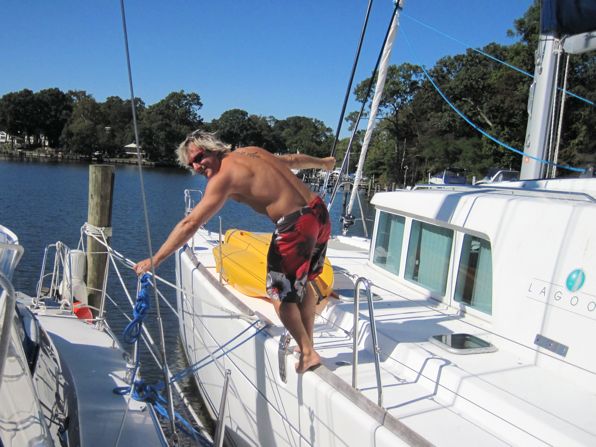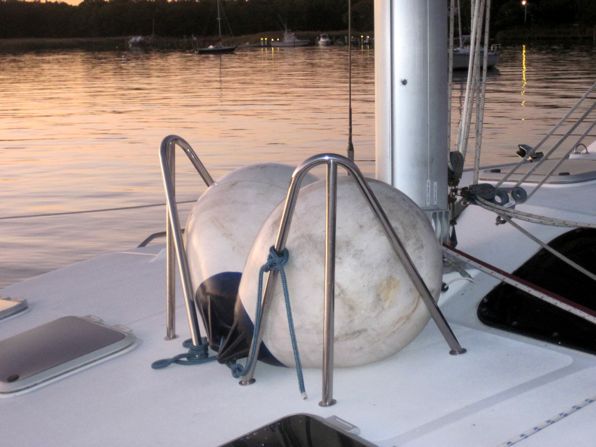The real mark of a cruiser
How can you tell a “real” cruiser from a recreational boater? You can’t tell by the fancy burgees (flags) in their boat’s rigging. Nor can you tell by the anchor on their bow (although a nice big one is a pretty good sign). We’ve determined that the best way to tell if someone is a (long distance) cruiser is by the fuel and water jerry cans carried on their deck. I remember hearing from someone that certain charter operations would actually tell their customers to find boats with jerry cans on deck and to anchor nearby them, assuming that they would know what they are doing!
Before anyone pipes up and says something (John!), yes, we do have a sailboat, but we have (sadly) learned that relying solely upon the wind for propulsion could make for some very long days. Yesterday would have been a great example of this! Our boat carries 27 gallons of gasoline in its main tank and burns approximately 1 gallon per hour when running on 1 engine. Although we won’t be making any huge runs until we get to the Mona Passage between the Dominican Republic and Puerto Rico, we are getting ourselves prepared.
The typical method for carrying jerry cans on deck is to string a board between two stanchions and lash the cans to it. There is only one really appropriate spot on our boat for this and the span between the stanchions there is about 6 feet. Because I think that is a fairly big span and I wanted something strong enough to support the weight of 3 cans, we decided to go with 2x6s, but what material to use? After debating for quite some time and counting our pennies, we decided to go with cedar. We purchased one 14 foot plank and had it cut in half, rounded the corners on each piece and sanded them smooth. I purchased some U-bolts from the hardware store to attach the boards to the stanchions but before doing so, was chastised by our friend Kirk for cheaping-out and not buying stainless steel ones. So, I guess it’s back to the chandlery then. 🙁
Once the cans (4 fuel and 2 water) are all ready to be attached, the final thing we need to do is to protect them from the sun. We have heard that the UV damage can be serious so Rebecca plans to sew a nice Sunbrella cover for each of them. We’ll post some more pics when we get it all done and looking pretty.

Checking the placement for the cans. We’ll carry 2 gas and 1 water can on each side.

Fortunately our friend Kirk has a good selection of power tools to speed up the job.

Getting between our boat and Kirk and Donna’s is a bit of a “stretch.”

On our way to the PDQ gathering. Heading into a new channel with the sun in your eyes is not recommended!

The proper “anchoring” pose… on the bow with hands in pockets. Pay attention… everyone does this!

We are currently rafted up to Eric and Bonnie’s PDQ 36 Desert Star. We think these large fender balls by the mast are a tad suggestive. 🙂



I recommend putting the 2 water jugs together on the same side.
Hi guys,
Yup we are at the Annapolis Boat Show,..unbelievable, tons of catamarans, and the seminars are great.
As mentionioned we will be at the Eastport Yacht Club Bash, we’ll keep an eye out for you..hope we can find you in the crowd….
Best regards,
Ron and Kath
Cool! Look for the matching black and white hats in the crowd. 🙂
It was great to meet up with you two. I’m glad you could find us amongst that crowd.
That is a beautiful piece of wood! Kind of a shame to cover it up with jerry cans! I agree with keeping the water cans together. Would be a shame to accidentally pour the gas in your water tank, not to mention dangerous, but also bad to put water in one’s gas tank! Engines don’t LIKE water! 🙂
I’m pretty sure we won’t make the water in the gas can mistake. They are different colours after all.
The first piece of electronics I bought for my boat was a twin transducer forward looking sonar from Interphase Tech. http://www.interphase-tech.com/iScan180se.htm
You will soon learn, when you sail beyond the coast of North America, that the GPS chart datums in use are sadly , and perhaps tragically in error.
MD Annapolis Electronic Marine, Inc. (410) 268-8101
MD Cambridge Midshore Electronics (410) 228-7335
MD Ocean City Midshore Electronics (410) 213-1212
MD Stevensville Martek Of Maryland (561) 626-0333
are three dealers in your immediate area.
That looks very cool John but it’s not at all cheap! I think we’ll have to wait and see if Santa brings us one of those.
Sunbrella covers are an absolute must, make sure you make one for the dink’s gas can too. Make ’em in different dark colors (one for gas, the other for water), and you won’t really have to worry about separating them. Just don’t assume a visiting guest will know!
It looks like the board is resting on top of a block for the roller furling – I would definitely try and avoid that.
Fair Winds,
Mike
Good eye Mike. It was just resting on that block for my test fit. I’ll fasten it up higher on the stanchions.
When you make the covers, don’t just do ‘slip-ons’ but ones with a flap that you can open to access the cap without taking the whole thing off. (How do I know this?) It makes life a lot easier.
Also think about how you’re going to transfer the liquids, possibly in a big sea. We swear by our superpumps (that’s what they’re called here) which are lengths of tube with a one way marble valve on one end. Shake it and get the flow going and your liquid moves … no electricity, no funnel, minimal spill (just a few drops if you’re not careful with the final withdrawal. No rude jokes please!)
We did sell these when we had a small chandlery biz but not for the last four years. The best link I’ve found is http://www.mailspeedmarine.com/search.bhtml?productNumber=&keyword=superpump&brand=10497885&leaf=&x=27&y=13 – sorry haven’t worked out how to do the links inside comments!
We have one of those siphon things too although we have yet to use it.
Mike,
I would also goto Autozone or Walmart and get 1 or 2 of those foldable window reflective panels. Will keep your fuel nice and cool.
I assume you mean to prop up against (or tie too) the cans while at anchor?
“We are currently rafted up to Eric and Bonnie’s PDQ 36 Desert Star. We think these large fender balls by the mast are a tad suggestive. ”
Only if your a single cruiser ! 🙂
I thought it was more than just a bit suggestive. With the erect mast, it seemed like a very happy boat.
🙂